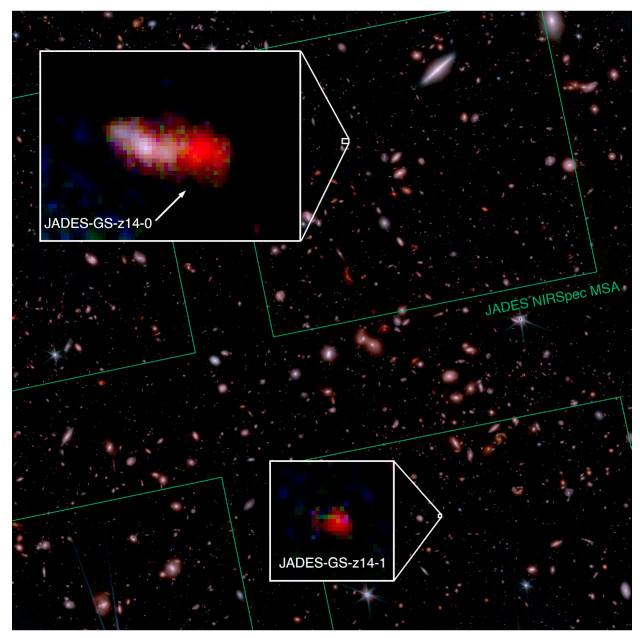
An article still in its peer-reviewed phase available in preview on the ArXiv server reports the identification of the primordial galaxies JADES-GS-z14-0 and JADES-GS-z14-1, which might be the most distant galaxies discovered so far. A team of researchers used observations conducted with the James Webb Space Telescope as part of the JWST Advanced Deep Extragalactic Survey (JADES) program to identify hundreds of candidate galaxies dating back to the first 650 million years of universe life. If the estimates made are confirmed, we see JADES-GS-z14-0 as it was about 290 million years after the Big Bang and therefore it would be the oldest known.
The image (S. Carniani, 2024; JADES Collaboration) shows the JADES-Gs-z14-0 and JADES-Gs-z14-1 galaxies as seen by the James Webb Space Telescope, also zoomed in the insets.
One of the goals of the James Webb Space Telescope is to find the first galaxies that formed in the history of the universe. The wait for new discoveries hasn’t been long with many primordial galaxies having been identified, but accurately measuring their ages at distances of more than 13 billion light-years is difficult.
There are cases in which even the nature of the discovered objects is in question: the JADES program identified JADES-GS-z13-0, considered among the primordial galaxies but an article published in the journal “Proceedings of the National Academy of Sciences” in July 2023 includes it among the candidate supermassive dark stars.
Classification aside, JADES-GS-z13-0 was perhaps the oldest known object but now the announcement arrived of the identification of JADES-GS-z14-0, a possible primordial galaxy that we see as it was around 290 million years after the Big Bang. The researchers used the NIRCam (Near-Infrared Camera) and MIRI (Mid-Infrared Instrument) instruments to detect it and NIRSpec (Near-Infrared Spectrograph) to study its emissions.
The estimated distance of the JADES-GS-z14-0 galaxy is so great that it made it difficult to study it. The first traces were identified at the end of 2022 in images from the NIRCam instrument, in which it was absent in the images in the blue filters. However, it was very bright in the images obtained with MIRI in the mid-infrared. The data collected with NIRSpec arrived in January 2024.
The JADES-GS-z14-0 galaxy is very bright, much more than expected for such a young galaxy. Stefano Carniani of the Normale di Pisa, Italy, lead author of the study, explained that the information indicates that it’s probably already enriched with dust and oxygen atoms produced by the stars inside it. That’s a level of evolution that is expected after a few hundred million years, not 290 million years after the Big Bang. He added that JADES-GS-z14-0 appears to have reached the stage of evolution we see now in about 10 million years. If that’s confirmed, it will be necessary to review theoretical models of galactic evolution.
Other results obtained by the JADES program are illustrated in an article accepted for publication in “The Astrophysical Journal” which describes the characteristics of various galaxies, including the diversity detected. These are other surprising results in the study of primordial galaxies which once again, confirm the extraordinary performance of the James Webb Space Telescope.
Astronomers hope that at least one of the programs aimed at investigating the early universe will be able to identify the first galaxies, which may have formed when the universe was 100-150 million years old. It’s difficult work, so much so that the results obtained with the JADES-GS-z14-0 galaxy are still being examined to understand whether the data obtained have been interpreted correctly.

